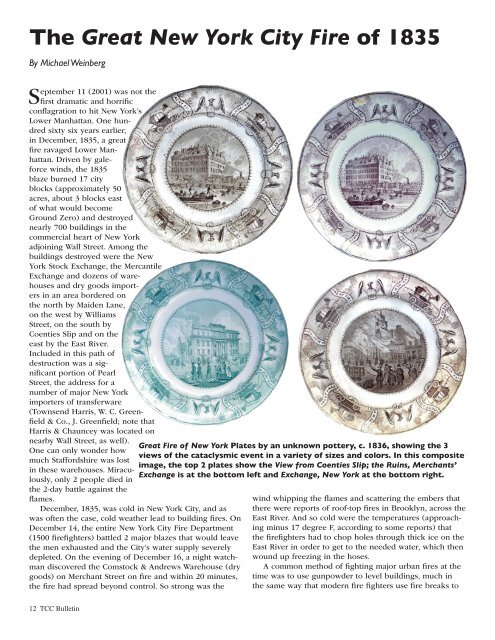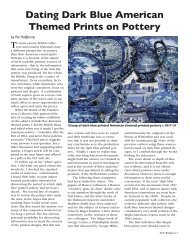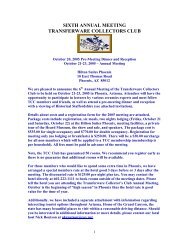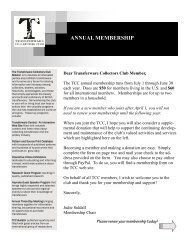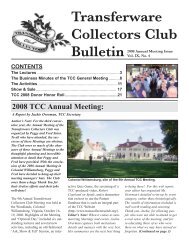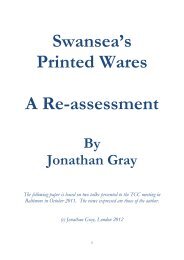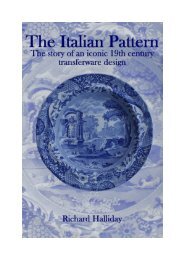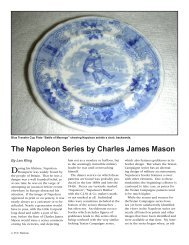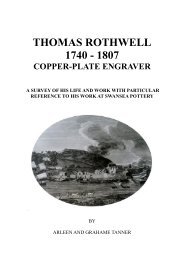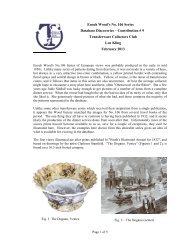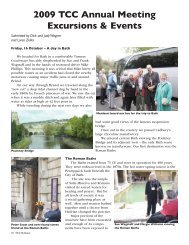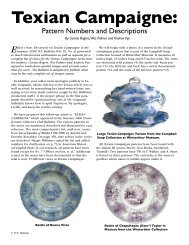The Great New York City Fire of 1835 - Transferware Collectors Club
The Great New York City Fire of 1835 - Transferware Collectors Club
The Great New York City Fire of 1835 - Transferware Collectors Club
You also want an ePaper? Increase the reach of your titles
YUMPU automatically turns print PDFs into web optimized ePapers that Google loves.
<strong>The</strong> <strong>Great</strong> <strong>New</strong> <strong>York</strong> <strong>City</strong> <strong>Fire</strong> <strong>of</strong> <strong>1835</strong><br />
By Michael Weinberg<br />
September 11 (2001) was not the<br />
first dramatic and horrific<br />
conflagration to hit <strong>New</strong> <strong>York</strong>’s<br />
Lower Manhattan. One hundred<br />
sixty six years earlier,<br />
in December, <strong>1835</strong>, a great<br />
fire ravaged Lower Manhattan.<br />
Driven by galeforce<br />
winds, the <strong>1835</strong><br />
blaze burned 17 city<br />
blocks (approximately 50<br />
acres, about 3 blocks east<br />
<strong>of</strong> what would become<br />
Ground Zero) and destroyed<br />
nearly 700 buildings in the<br />
commercial heart <strong>of</strong> <strong>New</strong> <strong>York</strong><br />
adjoining Wall Street. Among the<br />
buildings destroyed were the <strong>New</strong><br />
<strong>York</strong> Stock Exchange, the Mercantile<br />
Exchange and dozens <strong>of</strong> warehouses<br />
and dry goods importers<br />
in an area bordered on<br />
the north by Maiden Lane,<br />
on the west by Williams<br />
Street, on the south by<br />
Coenties Slip and on the<br />
east by the East River.<br />
Included in this path <strong>of</strong><br />
destruction was a significant<br />
portion <strong>of</strong> Pearl<br />
Street, the address for a<br />
number <strong>of</strong> major <strong>New</strong> <strong>York</strong><br />
importers <strong>of</strong> transferware<br />
(Townsend Harris, W. C. Greenfield<br />
& Co., J. Greenfield; note that<br />
Harris & Chauncey was located on<br />
nearby Wall Street, as well).<br />
One can only wonder how<br />
much Staffordshire was lost<br />
in these warehouses. Miraculously,<br />
only 2 people died in<br />
the 2-day battle against the<br />
flames.<br />
December, <strong>1835</strong>, was cold in <strong>New</strong> <strong>York</strong> <strong>City</strong>, and as<br />
was <strong>of</strong>ten the case, cold weather lead to building fires. On<br />
December 14, the entire <strong>New</strong> <strong>York</strong> <strong>City</strong> <strong>Fire</strong> Department<br />
(1500 firefighters) battled 2 major blazes that would leave<br />
the men exhausted and the <strong>City</strong>’s water supply severely<br />
depleted. On the evening <strong>of</strong> December 16, a night watchman<br />
discovered the Comstock & Andrews Warehouse (dry<br />
goods) on Merchant Street on fire and within 20 minutes,<br />
the fire had spread beyond control. So strong was the<br />
<strong>Great</strong> <strong>Fire</strong> <strong>of</strong> <strong>New</strong> <strong>York</strong> Plates by an unknown pottery, c. 1836, showing the 3<br />
views <strong>of</strong> the cataclysmic event in a variety <strong>of</strong> sizes and colors. In this composite<br />
image, the top 2 plates show the View from Coenties Slip; the Ruins, Merchants’<br />
Exchange is at the bottom left and Exchange, <strong>New</strong> <strong>York</strong> at the bottom right.<br />
wind whipping the flames and scattering the embers that<br />
there were reports <strong>of</strong> ro<strong>of</strong>-top fires in Brooklyn, across the<br />
East River. And so cold were the temperatures (approaching<br />
minus 17 degree F, according to some reports) that<br />
the firefighters had to chop holes through thick ice on the<br />
East River in order to get to the needed water, which then<br />
wound up freezing in the hoses.<br />
A common method <strong>of</strong> fighting major urban fires at the<br />
time was to use gunpowder to level buildings, much in<br />
the same way that modern fire fighters use fire breaks to<br />
12 TCC Bulletin
slow brush and forest blazes. Unfortunately, there wasn’t enough<br />
gun powder in Manhattan on the night that the fire was discovered<br />
and it wasn’t until Marines from the Brooklyn Navy<br />
Yard arrived with the explosive the next day that this<br />
technique could be implemented, successfully.<br />
<strong>The</strong> “<strong>of</strong>ficial report” after the fire traced its origin<br />
to a burst gas pipe, ignited by a coal stove at the<br />
Comstock and Andrews Warehouse. <strong>The</strong> economic<br />
impact <strong>of</strong> the fire was devastating: loss estimates<br />
ranged between $20 million and $30 million<br />
dollars (<strong>1835</strong> dollars, remember) and 3 <strong>of</strong> <strong>New</strong><br />
<strong>York</strong> <strong>City</strong>’s 26 fire insurance companies went<br />
bankrupt as a result <strong>of</strong> their losses.<br />
Yet “good” did come from this disaster: the<br />
Erie Canal had only recently opened in <strong>1835</strong>,<br />
and that waterway created a vast market for<br />
imported goods (including transferware and<br />
other English ceramics), and allowed the warehouse<br />
owners and merchants in Lower Manhattan<br />
to rebuild their infrastructure with stronger<br />
brick and stone buildings. <strong>The</strong> <strong>Great</strong> <strong>Fire</strong> also led<br />
to the creation <strong>of</strong> <strong>New</strong> <strong>York</strong>’s municipal water supply<br />
and the building <strong>of</strong> the Croton Aqueduct, bringing<br />
plenty <strong>of</strong> fresh water to the <strong>City</strong> from the North. And<br />
perhaps most importantly, the <strong>Great</strong> <strong>Fire</strong> led to an examination<br />
<strong>of</strong> and major improvements to <strong>New</strong> <strong>York</strong> <strong>City</strong>’s fire fighting<br />
services, and the result was that the <strong>City</strong> has never since experienced<br />
a widespread catastrophe.<br />
Brown transfer 10”<br />
dinner plate showing<br />
Exchange, <strong>New</strong> <strong>York</strong><br />
burning out <strong>of</strong> control,<br />
with the printed mark.<br />
Ruins, Merchants’ Exchange<br />
on a green transfer, 10”<br />
plate, with printed mark.<br />
At least one Staffordshire potter, perhaps because<br />
<strong>New</strong> <strong>York</strong> importers had been victims, or perhaps<br />
because it saw an opportunity to make money,<br />
was quick to immortalize the <strong>Great</strong> <strong>Fire</strong> <strong>of</strong> <strong>New</strong><br />
<strong>York</strong> in transferware. An unknown pottery, c.<br />
1836, created a series <strong>of</strong> 3 transfer views on<br />
plates (ranging in size from 6 ¾” to 10”). Produced<br />
in light blue, pink, green, purple, black<br />
and brown, these views include:<br />
1) Exchange, <strong>New</strong> <strong>York</strong>: a dramatic image<br />
<strong>of</strong> the Stock Exchange building in flames, as<br />
firefighters stand helpless in the foreground;<br />
2) Ruins, Merchant’s Exhange: an image <strong>of</strong> the<br />
remains <strong>of</strong> the commodity market after the fire;<br />
3) View from Coenties Slip: Coenties Slip was<br />
an artificial inlet <strong>of</strong> the East River, built to accommodate<br />
the unloading and loading <strong>of</strong> merchant<br />
ships. This scene shows firefighters on the river attempting<br />
to douse a burning warehouse.<br />
All views in the series have a dramatic border showing<br />
fire pumpers (probably state-<strong>of</strong>-the-art equipment<br />
for the period) and eagles, separated by banners reading<br />
“<strong>Great</strong> <strong>Fire</strong>, <strong>City</strong> <strong>of</strong> <strong>New</strong> <strong>York</strong>.” Most plates have a<br />
printed spread eagle cartouche with the name <strong>of</strong> the<br />
scene. Above the eagle’s head is the letter “D” and “Stone<br />
Ware” is also printed in the mark.<br />
TCC Bulletin 13
<strong>The</strong> <strong>Great</strong> <strong>New</strong> <strong>York</strong> <strong>Fire</strong> series is unique among<br />
American Historical Staffordshire transfers in that it<br />
seems to have been produced for the American market<br />
and it portrays a disaster <strong>of</strong> cataclysmic proportions.<br />
All other American views celebrate positive events,<br />
locations or developments in the history <strong>of</strong> the<br />
new nation, even at the expense <strong>of</strong> the British<br />
(MacDonough’s Victory, for example, or the<br />
Landing <strong>of</strong> Lafayette, which celebrates the<br />
Marquis’ popularity for helping the Patriots’<br />
cause during the American Revolution).<br />
Yet at least one British potter felt<br />
that there would be a market for these<br />
transfer scenes, and even went to the<br />
trouble and expense to produce them<br />
in numerous colors. It would be interesting<br />
to find the source prints for<br />
these plate, the popularity <strong>of</strong> the Series<br />
and its distribution in mid-19th century<br />
America as well as whether they were<br />
sold exclusively in <strong>New</strong> <strong>York</strong> <strong>City</strong>, or<br />
found markets elsewhere. And perhaps<br />
these plates were the precursors to the public’s<br />
fascination with disasters, both natural<br />
and man-made, as seen with the popularity<br />
<strong>of</strong> late 19th and early 20th books dealing with<br />
such calamities as the San Francisco Earthquake,<br />
the eruption <strong>of</strong> volcanoes around the world, and later<br />
with events such as the sinking <strong>of</strong> the Titanic and the<br />
torpedoing <strong>of</strong> the Lusitania.<br />
<strong>The</strong> plates shown in the illustrations for this article<br />
were provided by Bill and Terry Kurau and the photographs<br />
themselves were taken by Lois Chase <strong>of</strong> Springfield,<br />
MA.<br />
View from Coenties Slip. Note<br />
that the artist <strong>of</strong> the source<br />
print must not have been aware<br />
that the East River had frozen<br />
over at the time <strong>of</strong> the fire.<br />
<strong>The</strong> common border on all three<br />
view from the <strong>Great</strong> <strong>Fire</strong> <strong>of</strong> <strong>New</strong><br />
<strong>York</strong> Series, showing a “modern”<br />
firer pumper and the<br />
American Eagle, along<br />
with the banner<br />
identifying the<br />
Series.<br />
14 TCC Bulletin


